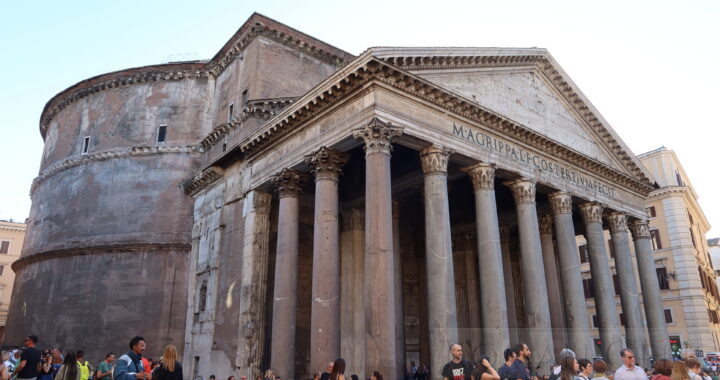- The Pantheon Temple in Rome was started and completed by Hadrian in 128 CE.
- It has the world’s largest unsupported concrete dome making it one of the Seven Wonders of Ancient Rome.
Getting There
- Location: Piazza della Rotonda, Rome.
- Nearest Metro Station: Barberini, Line A.
History
- The Temple of Mercury (or the Temple of Echo), at Baiae had the largest Dome in the world until the Pantheon was completed in 128 CE.
- The original Pantheon was built by Agrippa in 27 BCE, during the Reign of Augustus.
- However this was destroyed by fire in 80 CE and rebuilt. It was then destroyed by fire again in 110 CE and completely rebuilt but only completed under Hadrian in 128 CE.
- It was built as a Temple and the name Pantheon implies that it was dedicated to all the Roman Gods. In Greek, the word ‘Pantheon’ means a ‘Temple dedicated to all Gods’.
- The Pantheon was also used as a Law Court, one of the three buildings where the Emperor sat as a Judge and heard petitions and passed Laws. It was the only such building open to the Public, where they could observe the Emperor at work.
Construction
The Dome
- The Pantheon still holds the world’s largest unreinforced concrete Dome.
- The concrete Dome, if it was turned upside down, would fit perfectly inside the Pantheon forming a sphere.
- Therefore the height from floor to the Oculus, and the diameter of the Pantheon are identical: 150 Roman Feet.
- The Dome is supported by eight barrel vaults supported by eight piers.
The Oculus
- There is a hole at the top of the Dome, called the Oculus, which lets sunlight in. Oculus means eye in latin. The Oculus is 30 Roman Feet in diameter. Rainfall that enters the Oculus and falls into the Pantheon, is removed by drains.
The Portico
- The entrance is a rectangular Portico supported by sixteen pillars.
- The Pillars for the Portico came from a Quarry in Egypt called Mons Claudianus, located in the Eastern Mountains near the Porphyry Mountain. These Pillars were dragged to the Nile, then floated down to Alexandria, where they were shipped to Ostia, barged up the Tiber. and finally dragged over to the Site of the Pantheon.
- The niches at the back probably held Statues of the Gods.
The Doors
- Two great Bronze doors covered in Gold, protected the Temple.
Other Buildings influenced by the Pantheon in Rome
- Le Pantheon (1790 CE) in Paris, France.
- The United States Capitol (1800) in Washington DC, USA.
- Jefferson Memorial (1943 CE), Washington DC, USA.
- National Gallery of Art (established 1937 CE), Washington DC, USA.
- St. Paul’s Cathedral (consecrated 1697 CE) (possibly influenced by the Pantheon).
The Theory of the Pantheon as a Reverse Sundial
- This Theory is proposed by two academics, Giulio Magli, a historian of Ancient Architecture at Milan Polytechnic, Italy, and Robert Hannah, a classics scholar at Otago University, New Zealand. The articles were published in the Daily Telegraph and the Daily Mail
- The Dome of the Pantheon forms the top half of a perfect sphere, from the top down to the floor.
- The Oculus at the top of the Dome, produces a circular shaft of sunlight, which rotates in reverse direction to the direction of travel by the Sun.
- During Winter, between October to March, the Shaft of sunlight illuminates only the inside of the upper dome.
- At 12.00 noon on March 21st, the Spring Equinox, the circular shaft of sunlight perfectly fits the arch above the entrance.
- Between the Equinoxes, March 21st to October 21st, the shaft of sunlight coming through the Oculus reaches the floor.
- At 12.00 Noon on April 21st, the shaft of sunlight passes through a gap above the entrance and lights up the inside of the Portico. This coincides with the Foundation of Rome or Dies Natalis of Rome, which was celebrated by the Festival of Parilia, renamed by Hadrian to become the Festival of Romae.
- The Pantheon was also used as a Law Court, one of the three buildings where the Emperor sat as a Judge and heard petitions and passed Laws. It was the only such building open to the Public, where they could observe the Emperor at work.
- It is possible that Hadrian, acting in his role as Chief Priest, Pontifex Maximus, may have timed his entry into the Pantheon for 12.00 on the 21st April.
- The Pantheon would have reinforced the connection of the Roman Emperor between Divine Power and Earthly Power.
- If the Pantheon acted as a Sundial, then at night during the Full Moon, it would also act as a Moondial, and the Lunar Eclipse could be observed.
Photo and map: Pantheon, Rome

